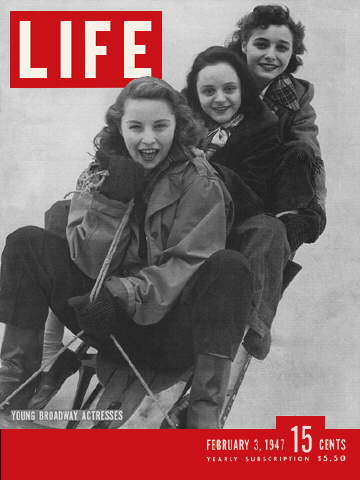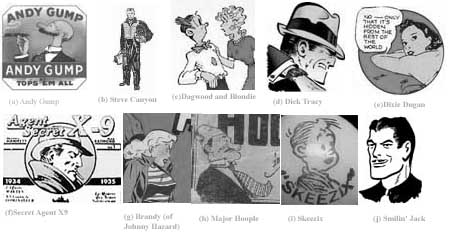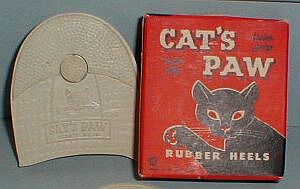
Week of February 3, 1947
Young Broadway Actresses
Peace of Mind
I was very fortunate to find a set of bound volumes of LIFE Magazine for the year 1947. Since 2004 is just beginning, I thought that it would be appropriate to meander through 1947 one week at a time to see how things have (and haven't) changed in 57 years. By the way -- the bound volumes came from the library of Bridgewater College (in Bridgewater, Virginia...) Are there any alumni out there who would like to share campus lore from this august institution -- especially during 1947?
Click here to see excerpts from other LIFE magazine issues during 1947
Thanks to Google Books, you can click here to read the entire February 3, 1947 issue of LIFE Magzine. You can look at some of the images that we refer to but cannot post due to copyright.
We are always glad to hear from our readers: e-mail us by clicking here
The February 3 issue featured three Brodway actresses, who ultimately achieved some recognition and fame.
In the front is Susan Douglas who was starring in the celebrated stinker "The Private Affairs of Bel Ami" that has been so extensively advertised during the past five weeks. Susan went on to star in a few lackluster Broadway productions and had a long-running role ion the Guiding Light soap opera. In 1966, she founded the Young Peoples Theater of Toronto.
In the middle is Patricia Kirkland who appeared in several plays on Broadway until 1948, when she married Donald Bevan, who is best known as the author of the Prison Camp drama Stalag 17.. She then retired from the stage.
On the back of that sled is a very young Patricia Neal, who had an astounding career which included an Oscar for the film Hud and numerous other outstanding performances including THE FOUNTAINHEAD, THE HASTY HEART, BRIGHT LEAF,(!)THE DAY THE EARTH STOOD STILL, A FACE IN THE CROWD, BREAKFAST AT TIFFANY'S,IN HARM'S WAY, and THE SUBJECT WAS ROSES.
The Bell System ran an institutional ad that apolgized for the Telephone company's inability to meet the vast postwar demand for telephone service. The company could install only 300,000 phones a month. This surge was the result of wartime prosperity and a general belief that a phone was a necessity not a luxury. The physical and technical demands for wiring America were major stimuli in the development of Information Technology as a legitimate field of scientific endeavor. Things like all digit dialing and automatic switching had been pipe-dreams in the 1920s and 1930s, but the phone company got very serious about these things in 1947. Check out our page on Vintage Telephones to learn how the industry was pursuing this goal. Basically everything that we know about computers stems from either World War II or the push to hook America into the phone system. Effectively, this little ad brought you the internet (not Al Gore...)
LIFE devoted its editorial to the subject of "Peace of Mind", a phrase attributed to Existentialist philosopher Albert Camus: "In the midst of a world withered by hate, every one of us must learn to say in all peace of mind that he is no man's mortal enemy."
It seems that after the Depression and World War II, sufficient prosperity had returned so that the public had begun to worry about things like "personal satisfaction". Surveys indicated that maybe 8 million Americans were "severly neurotic" and a much larger number were dissatisfied with life. The editorial examined all the possible pallatives such as socialized medicine, sharing the wealth, more precise language, and fresh air in the country. After some rumination, LIFE concluded that Christianity was the Answer. Camus had no answer,then or ever.
However, LIFE hedged its bets somewhat -- they aslo did a six page spread on Psychoanalysis. They actrually did a fairly good job of simplifying the complexities of Freud, Jung and Adler for an audience conditioned to buy hair tonic to get laid. The article was lavishly illustrated by Boris Artzybashef, who was well known for his anthropomorphic drawings of machines that graced the covers of LIFE' sister publications, TIME and FORTUNE.
A five page article was devoted to the Bushmen of the Kalahari, the same tribe that was made famous in the comedic film The Gods Must Be Crazy. In 1947, these brave little people were continuing to struggle in their hostile environment. They have a surprising amount of dignity and character in their faces, especially in comparison with the overfed members of the Connecticut Governor's Guard (see below...). The article is fairly condescending. Since these were "savages" of color, it was acceptable for LIFE to print photographs of bare-breasted women from the tribe. This was one of the more irritating conventions of journalism in the mid 20th century...
There was a riot at a bullring in Mexico City. Apparently, one Lorenzo "El Magnifico" Garza had done a rather listless job of dispatching a bull, as compared to the next guy on the card, who went on to become the celebrated Manolete (also the subject of the 2003 Eminem song "The Death of Manolete".) A fan in one of the high priced seats began a non-stop stream of heckling that berated the parentage and finaly the masculinity of "El Magnifico". At this point, the matador forgot the bull and invaded the stands. A riot ensued in which the fans set fire to the grandstand. Presumably, the bulls got to watch this, possibly shouting "Ole" as matador and fan brawled.
The Big News was that Labor and Management had sat down together. The occasion was a meeting between the executives of Big Steel and the Congress of Industrial Organizations (C.I.O.) In contrast to the past year, a steel strike was avoided. Although this played well in the press, it marked the start of a collaboration between Big Labor and Big Business that lasted until the 70s. Thus, instead of one group trying to get something from the other, labor and management cooperated to soak the general public. Bargaining on an industrywide basis equalized labor costs across whole sectors of the economy and freed management from competitive pressure. This arrangement soaked the public as inferior goods were foisted upon them at high prices.
As an example of the bad Old style of Labor-Management relations, LIFE ran a two-page spread on the Allis-Chalmers strike just outside of Milwaukee. There were plenty of pictures of pickets and scabs being stoned and cops hitting workers. The undercurrent was that the "left wing" part of the "Red-Led" union was to blame. Fortunately, a new "right-wing" leadership was on its way into the union to make sense out of the nonsense by "accomodating".
Even as compliant union leaders were accomodating management, the new Republican Congress was drafting anti-union language on a scale that was unheard of -- national prohibition of the closed shop, elimination of industry-wide bargaining and secondary boycotts. A FORTUNE poll showed that 49% of the public felt that America would be better off without unions. I wish they could have been given a crystal ball to see the future!
Nearly 20 years of this "cooperation" produced substantial votes for George Wallace and Richard Nixon among union members in the 1968 presidential election, particularly the steelworkers. In 1975, almost all of their jobs were exported to Asia while their unions did virtually nothing as their Leaders ate caviar in marble palaces within sight of the White House. Unions had become accustomed to "accomodation".
These "Tuxedo Unions" left Pittsburgh a wreck populated by legions of former Steelworkers grubbing for minimum wage jobs. After Steel, the horror of "downsizing" spread across the land from industry to industry. Pick up any piece of shoddy goods that you see in Wal-Mart -- and take the time to notice where it is made. You are asked to pay good money for stuff from far-off dictatorships made by people who work for 10 cents a day and a hot lunch.
We can thank LIFE magazine in 1947 for providing us with a concrete example. Their cameras went to Kankakee, Illinois to document the opeining of the A.O. Smith Company's brand water heater new factory. Built with a grant of some $5 Million ($150 Million today...) from the State of Illinois, it was touted as the most efficient factory in the world, turning out 180 new water heaters an hour and brought $63,000 a week to the city in payroll. Automation had drastically reduced the number of workers that were required. [At the end of the article, there was a drawing of the fully automated "Factory of the Future" that would employ nobody, resulting in "lower prices," sort of like what you get at Wal-Mart today...]
Today, the plant in Kankakee is long closed, and the Modern A.O. Smith Company makes water heaters in Juarez, Mexico and Nanjing, China. Who in the bright postwar years of the 1940s could have guessed that the real "Factory of 2000" would be operated by slave labor in Elbonia...
This all started in 1947 when America used to manufacture something besides lawsuits.
Perhaps you think this language is too strong. Some of you may have been conditioned by society to think of unions as "inefficient", or "low status", or in some other negative fashion. Some of you may even be proud that you have a "White Collar" job like computer programmer or engineer. WRONG. To management -- especially MBAs -- you are NOTHING, repeat NOTHING but a unit of production. It doesn't matter how you dress, it doesn't matter what you do, it doesn't matter where you went to school -- if they can find 80% of your smarts at 10% of the cost, you are gone, gone, gone. There are vast numbers of people in Mexico and India with degrees in engineering who will work for $1 a day. If your wage is $20/hr they can hire 20 engineers to do what you do for the same price. Sure, 18 of them will be doofuses. They try them out, keep the 2 and dump you. Not only that, they make a meritocracy argument that you should give up your job. When it happens, you will have a newfound appreciation for one of those big, bad, "take no crap" unions of the 1930s. Maybe you might be just a little tempted to toss a brick (figuratively, of course) at the scab who took your job. Maybe you wouldn't mind if guys like Benjamin Siegel had a little chat with the guys who handed you the pink slip. Maybe you'll have a little sympathy for all the other laboring men who gave up their work so that a comparatively small nest of yuppies can live in "global" luxury. Of course, it won't happen to you. Will it?
A fairly long article traced the history of the very successful Jack Benny program, which dominated the radio airwaves from 1933 throught the 1950s when it was a smash on TV. To a large extent, Jack Benny was the first "victim" comedian, who had his faults and was always being put down by the world. Born Benjamin Kubelsky, the famous comedian actually started out as a violinist in vaudeville, with an act called Salisbury and Kubelsky and later Salisbury and Benny. In fact, Jack Benny was quite an accomplished violinist (his concerts at the Hollywood Bowl outdrew Yehudi Menuhin, the acknowledged greatest violinist of the times), but he had ever so much more to offer as a comedian.
There is a very large amount of internet bandwidth devoted to the Jack Benny program, so I will not well on it much other than one aspect: Everyone on the program was Jewish, but there was virtually no reference to Jewish culture. Every year, the entire month of December was devoted to Jack's Christmas shopping. In 1947 this changed when the program introuduced Artie Auerbach as "Mr. Kitzel" the hot dog vendor. His tag phrase was "Have a hot dog with a pickle in the middle and the mustard on top, just the way you like 'em and they're always hoooooooooot! ", delivered in a Yiddish accent. Kitzel was the only character that ever came close to being Jewish. Within a week, the "peekle in de meedle" was a national catchphrase, and Auerbach continued to play Mr. Kitzel long after he had left the Benny program. He even recorded a song called (of all things) "Pickle in the Middle" with Frankie Laine.
Of note for trivia buffs: Jack Benny's last TV appearance was also the last time Yehudi Menuhin was seen on TV; however what might have been earthshaking news in the 1940s was vastly overshadowed by the appearance of John Lennon and Yoko Ono
LIFE devoted three pages to an Italian girl named Assuntina who had a thing about Olive Trees. Specifically, she saw the frenzy of the ballet in their twisted shape. In order to make her point, she went into an olive orchard and imitated some of the shapes. In this three page spread, her ample form is clothed in a pair of Dr. Denton's long johns. This generated weeks of letters to the editor. Assuntina (1927-1986) went on to become a celebrated Clown in circuses around Italy, specializing in a contortionist act.
Leo "The Lip" Durocher, colorful manager of the Brooklyn Dodgers had gotten himself into a pickle -- he had just married actress Laraine Day, but was shocked to find out that his bride's previous divorce had been held invalid. Hence, the new Mrs. Durocher was technically a bigamist (LIFE went out of its way to note that Ms. Day was a Mormon...) Eventually things were worked out that the couple could stay married, but they could not live together for a year. LIFE did not miss the opportunity to portray Ms. Day in a two-piece swimsuit. At the time, the new Mrs. Durocher was starring with Cary Grant in the film Mr. Lucky. LIFE makes the point that Mr. Durocher was quite the ladies' man. However, I am sitting here looking at a picture of an overweight, middle age man with a bad comb-over. Maybe beautiful women had different standards in the 1940s...
A three page spread detailed the heroic efforts of the Connecticut Governor's Foot Guard. (There is also a Horse Guard...) This is a paramilitary organization that exists to escort the Governor of Connecticut. This is the oldest serving regiment in American history, predating the Marines and the Coast Guard. The regiment has not seen combat since the Revolutionary War. This article shows the marshalling of the Guard on the occasion of the innauguration of newly elected Governor James L. McConaghy. The uniforms are outlandish in the extreme, based on the big bearskin hats of the Coldstream guards, with swords, big epaulettes and knee-boots. All of the guardsment pictured were substantially overweight, adding to the humor of the event. The article has one interesting note: new Governor McConaghy was a college professor who bears a startling resemblance to Wally Cox, the character actor who specialized in playing meek, retiring men. The article goes on to say that there was a long tradition ofin Connecticut of electing college profesors to the Governorship. How about that?
A two-page spread dealt with the efforts of Science ( a guy in a lab coat) to study Motion Sickness. They had developed a gadget that looked like a big cocktail shaker that induced motion sickness. Even more disgusting devices were used to study dogs and cats. But, there were lots of dials and oscillioscopes, so it must have been Science. A substance called "Hyoscine" was identified as a potential cure.
In the final article, ten of the most famous cartoonists were asked to draw their principal character; then they were blindfolded and asked to draw the same character. They failed miserably....
Here are the cartoonists: (1)Frank King, (2)John Striebel, (3)Chic Young, (4)Gus Edson, (5)Frank Robbins, (6) Chester Gould, (7) Bill Freyse, (8) Mel Graff, (9) Zack Mosely, (10)Milton Caniff
Can you match the artists with their cartoon characters?

Answers next week
A regular feature was photo coverage of a celebrity party. This week, LIFE went on a weekend in the country with the three Broadway starlets pictured on the cover. They and their boyfriends seemed to have a marvelous time mugging for the magazine's photographers
LIFE went to the opera this week and profiled Mozart's Don Giovanni (or Don Juan)a thoroughly entertaining chronicle of lechery, crime and punishment set to some of the best music ever conceived by man. Of interest is the fact that LIFE, a journal of "average" American taste would quote Soren Kierkegaard, one of the most abstruse philosophers of all time. (imagine Beavis and Butthead quoting the I Ching...) My favorite aria is the Madamina, in which a long list of Don Giovanni's conquests is read (640 in Italy, 231 in Germany, 100 in France, 91 in Turkey and 1,003 in Spain) By the way, that rhymes in Italian... I am still amazed that LIFE devoted this much space to this remarkable opera.
Ads for the following films were run:
- Honeymoon in a fairly humorous series of escapades, Shirley Temple (at age 22) and Guy Madison chase all over Mexico City trying to get married before his Army furlough is up. They succeed and Temple (implicitly) loses her on-screen virginity as the ending credits roll over a sleeping car passing through a tunnel.
- Trail Street Western icon Randolph Scott plays the legendary "Bat" Masterson
- Born to Kill Lawrence Tierny is cast against type as a sociopathic killer
- The Farmer's Daughter Loretta Young and Joseph Cotten star in this classic film which was extensively promoted.
- On the back cover, Virginia Mayo plugs for Chesterfields, but they mention her role in the masterpiece The Best years of Our Lives which was such a smash hit that it would help sell cigarettes. Mayo plays a thoroughly detestable gold-digging wife who takes advantage of her returning veteran husband.
Ipana Toothpaste featured a "Mom to Model" ad, a reversal of their ad in the January 6 ad in which a Powers Model thanked Ipana for helping her to catch Mr. Right and become a Mom. In this case, a Mrs. Virginia Swensen won a beauty contest and switched from "modeling aprons in her kitchen" to modeling for a fashion agency. However Mom to Model or Model to Mom, both ladies seem to have plenty of time to spend with their adorable children...
The Book-of-the-Month Club was pushing B.F.'s Daughter, a book about a woman who inherits her father's vast empire and how it debilitates her husband; Pavillion of Women, a Pearl Buck novel deals with the intrigues within a harem of concubines in ancient China. This was not a month for empowered women...
Veneida Hair Nets unintentionally borrowws a catchphrase from the mouth of Sinclair Lewis' Babbitt: "The Best is Always the Cheapest".
Ethyl was the trade name for Lead Tetraethyl, a highly toxic compound that was added to gasoline to eliminate "knocking" due to premature combustion. (This is the stuff that was eliminated to make "unleaded" gasoline) For a while, the Ethyl corporation packaged this stuff as a household cleaner -- this ad touts its use on dishes of all things!
Record Ads: An ad for General Electric featured Kay Kyser plugging "natural color tone radios" along with his College of Musical Knowledge show.
RCA Victor ran a full page ad for classical music, featuring the work of Marian Anderson, Arthur Fiedler and William Kapell. In those days, the classical musicians had long hair, and Kapell's portrait with a swept forward pompadour makes him look like a teen rock star of the 1950s -- in fact when I first saw the photo, I thought that it was Phil Everly. See what you think:

Get the Girl Ads: Listerine toothpaste promised you that you would get a big Valentine from a "special Someone" if you used their product. Meanwhile, Vaseline hair tonic 's cutie found an inspiring composer was suffering from dry scalp; use of the tonic helped him "score" in a figurative sense.. Hire's Root Beer suggested that a fellow with good taste in root beer could score with a lovely coed. Jeris Hair Tonic suggested that you would "Always have hair she loves to touch"
Ladies in Undergarments: Jantzen Swimwear used a cartoon of an attractve young lady to announce their entry into the panty-girdle market
Speed It Up!: Sal Hepatica promised that it would "get rid of intestinal sluggishness fast when you have a COLD". Phillips Milk of Magnesia had a testimonial from a cartoon Mom that suggested that she could rid her family of "sluggishness" as well -- and the product was "so gentle for children and so thorough for grownups. Ex Lax was advertised as the "Happy Medium" laxative... The Sunkist group of citrus growers argued that you could "Keep regular the "healthful" way with just lemon juice and soda water (isn't that lemonade???)
Pictures of Babies: Campbell's Baby Soups featured an adorable child, but who would want to feed this prcious little thing lamb or liver soup? Well, the folks at Clapp's Baby Foods also ran a full page ad that ALSO featured liver soup! I was a baby back then -- I wonder if my mom was induced to feed me liver soup?
Who was Endorsing Pens? George Sanders (who died of boredom) endorsed Stratford Pens. At the time, Sanders was starring in the stinkeroo "The Private Affairs of Bel Ami
Retire on $150 a month? The Phoenix Mutual was back with an ad that showed a happy fellow driving along in a convertible smoking a pipe. He says "Life looks very good to me - I'm driving to Florida and then to Mexico... you see, I'm retired now with a check for $150 a month, every month, as long as I live." They did not say what he was smoking in the pipe...

Cats Paw Heels ran a regular ad
A very recognizable Art Deco image
The letters were fairly mundane, offering official praise for the Jan 13 issue's treatment of hotel fire safety and the special home design for a paraplegic veteran.
A bizarre series of letters concerned the article on resort fashions and particularly the cover of the January 13. One letter suggested that the models were "scrawny and looked like an overworked dishrag". Take a look at the cover photo -- if anything, these models would be considered OVERweight today! Another letter speculated that sexual adventurism had drawn the models to "Porto Rico" -- this in a national publication!!
The Back cover had an ad for Chesterfield cigarettes featuring actress Virginia Mayo dressed up as a fortune teller. She looks into her Crystal Ball and sees "A. B. C." ( Always Milder, Better tasting, Cooler Smoking, Always Buy Chesterfield) This was a sort of comeback to the "L.S/M.F.T." campaign for Lucky Strikes that was discussed last week.
Counter for the Entire Site (not just this page..)
Home | About Lindy | 1940s Collectibles | Upcoming Events | Vintage Clothing
The Guide - Establishments - Travel - Accessories
Music | Links | Photo Gallery | Extras | Contact